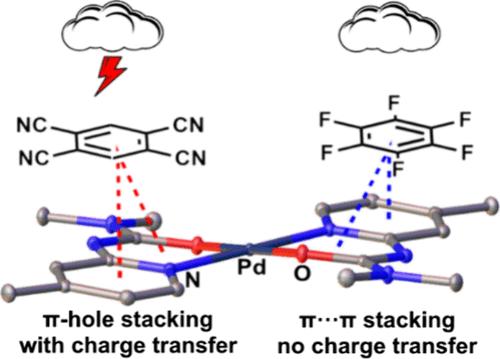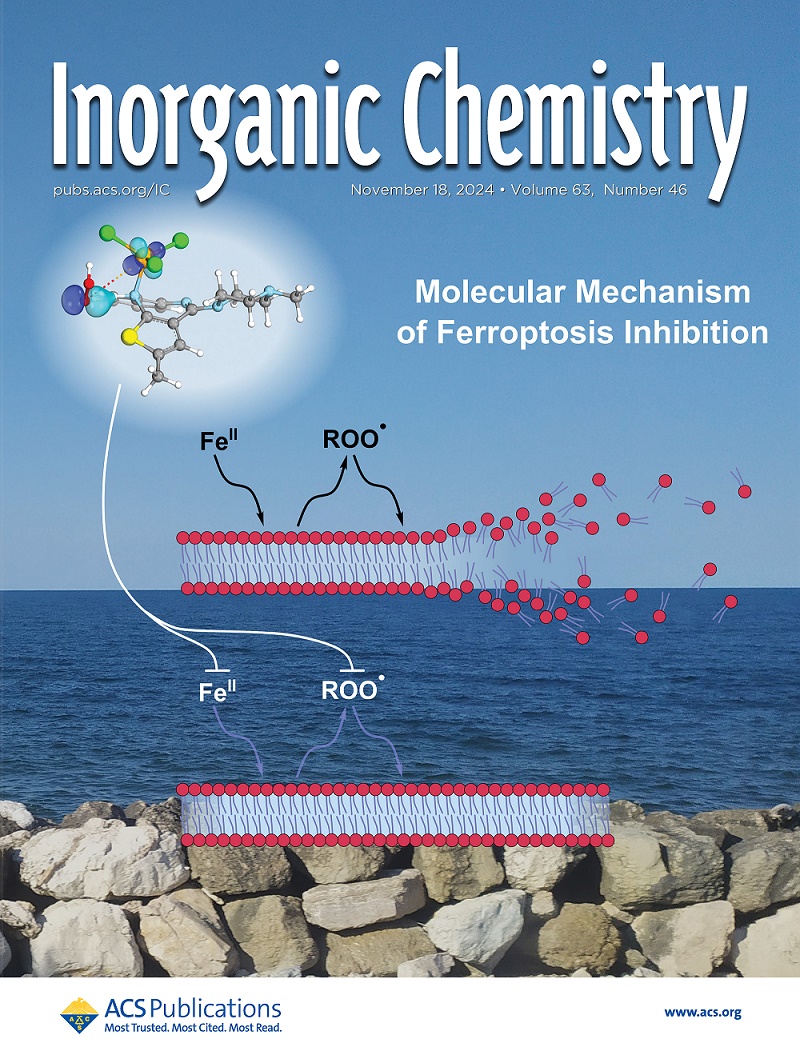Different Stacking Types in a Single Hybrid Cocrystal System: π···π- and π–Hole-Based Organic–Inorganic Planar Assemblies
IF 4.3
2区 化学
Q1 CHEMISTRY, INORGANIC & NUCLEAR
引用次数: 0
Abstract
The planar bis-chelated complex [Pd(N∩O)2] (1; N∩O = 4-MeC5H3NNC(O)NMe2) exhibits two distinct stacking modes with electron-deficient aromatics: π···π stacking with hexafluorobenzene (C6F6) versus charge-transfer π–hole interactions with 1,2,4,5-tetracyanobenzene (TCB). Cocrystallization of the complex with C6F6 or TCB yields cocrystals 1·3(C6F6) and 1·2TCB, respectively, which display different colors and stacking patterns despite similar structural motifs. Comprehensive analysis using X-ray diffraction, combined with quantum theory of atoms-in-molecules (QTAIM), an independent gradient model based on Hirshfeld partition (IGMH), extended transition state natural orbital for chemical valence theory with charge displacement function (ETS-NOCV/CDF), many-body interaction analysis, and symmetry-adapted perturbation theory (SAPT), reveals fundamentally different interaction mechanisms. In 1·3(C6F6), the stacking is primarily governed by intermolecular polarization without significant charge transfer, with dispersion forces contributing approximately 70% of the attractive energy. In contrast, 1·2TCB exhibits pronounced charge transfer (35 me) and significant inductive components alongside dispersion forces, characteristic of π–hole interactions. This dichotomy in stacking behavior provides new insights into the nature of organic–inorganic planar assemblies and demonstrates that seemingly similar structural patterns can arise from distinctly different combinations of noncovalent forces, which is essential for rational crystal engineering of hybrid materials.

平面双螯合复合物[Pd(N∩O)2](1;N∩O = 4-MeC5H3NNC(O)NMe2)与缺电子芳香族化合物呈现出两种截然不同的堆叠模式:与六氟苯(C6F6)的π---π堆叠,以及与1,2,4,5-四氰基苯(TCB)的电荷转移π-空穴相互作用。将该复合物与 C6F6 或 TCB 共晶体化后,可分别得到 1-3(C6F6)和 1-2TCB 共晶体,尽管它们的结构模式相似,但颜色和堆叠模式却各不相同。利用 X 射线衍射、分子内原子量子理论(QTAIM)、基于 Hirshfeld 分区的独立梯度模型(IGMH)、带电荷位移函数的化合价理论扩展过渡态天然轨道(ETS-NOCV/CDF)、多体相互作用分析和对称性适应扰动理论(SAPT)进行综合分析,发现了根本不同的相互作用机制。在 1-3(C6F6)中,堆叠主要受分子间极化作用的支配,没有明显的电荷转移,分散力贡献了约 70% 的吸引力能量。相比之下,1-2TCB 则表现出明显的电荷转移(35 me)和显著的感应成分,以及π-孔相互作用所特有的弥散力。这种二分法的堆叠行为为人们了解有机-无机平面组装体的性质提供了新的视角,并证明了看似相似的结构模式可能产生于截然不同的非共价作用力组合,这对于杂化材料的合理晶体工程至关重要。
本文章由计算机程序翻译,如有差异,请以英文原文为准。
求助全文
约1分钟内获得全文
求助全文
来源期刊

Inorganic Chemistry
化学-无机化学与核化学
CiteScore
7.60
自引率
13.00%
发文量
1960
审稿时长
1.9 months
期刊介绍:
Inorganic Chemistry publishes fundamental studies in all phases of inorganic chemistry. Coverage includes experimental and theoretical reports on quantitative studies of structure and thermodynamics, kinetics, mechanisms of inorganic reactions, bioinorganic chemistry, and relevant aspects of organometallic chemistry, solid-state phenomena, and chemical bonding theory. Emphasis is placed on the synthesis, structure, thermodynamics, reactivity, spectroscopy, and bonding properties of significant new and known compounds.
 求助内容:
求助内容: 应助结果提醒方式:
应助结果提醒方式:


